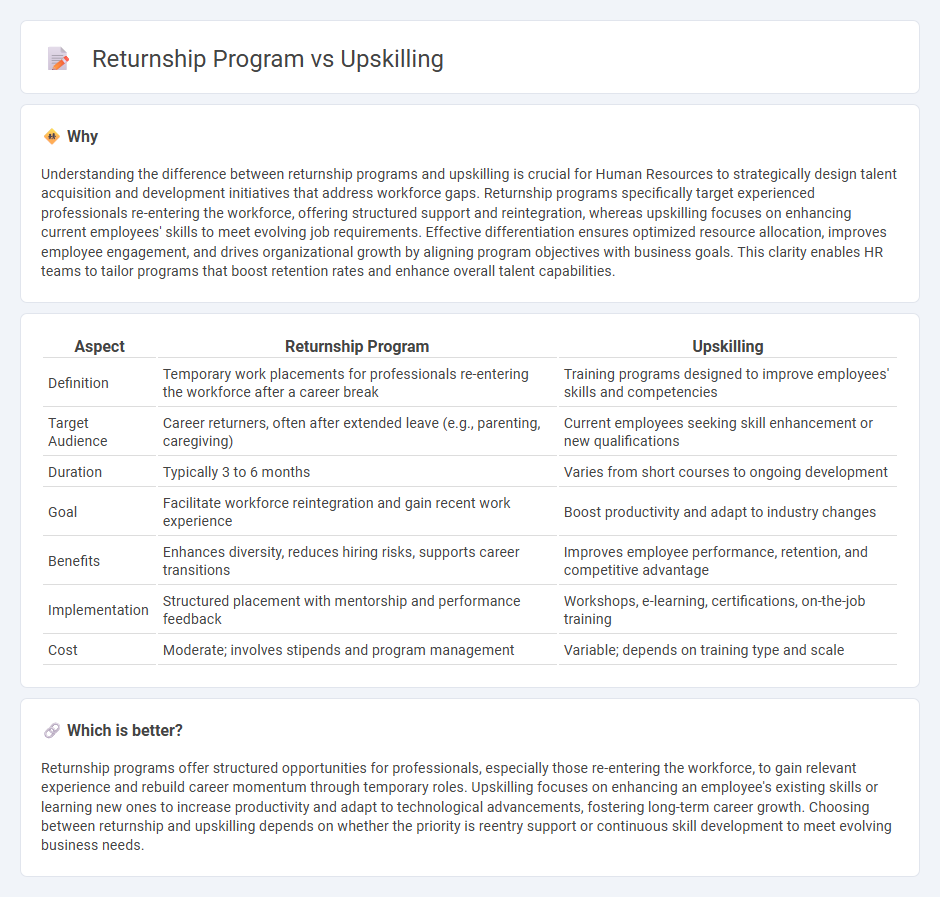
Returnship programs offer structured opportunities for professionals re-entering the workforce after a career break, focusing on hands-on experience and reintegration into their fields. Upskilling emphasizes enhancing current employee competencies through targeted training to boost productivity and adapt to evolving industry demands. Explore how integrating both strategies can optimize talent development and retention within your organization.
Why it is important
Understanding the difference between returnship programs and upskilling is crucial for Human Resources to strategically design talent acquisition and development initiatives that address workforce gaps. Returnship programs specifically target experienced professionals re-entering the workforce, offering structured support and reintegration, whereas upskilling focuses on enhancing current employees' skills to meet evolving job requirements. Effective differentiation ensures optimized resource allocation, improves employee engagement, and drives organizational growth by aligning program objectives with business goals. This clarity enables HR teams to tailor programs that boost retention rates and enhance overall talent capabilities.
Comparison Table
| Aspect | Returnship Program | Upskilling |
|---|---|---|
| Definition | Temporary work placements for professionals re-entering the workforce after a career break | Training programs designed to improve employees' skills and competencies |
| Target Audience | Career returners, often after extended leave (e.g., parenting, caregiving) | Current employees seeking skill enhancement or new qualifications |
| Duration | Typically 3 to 6 months | Varies from short courses to ongoing development |
| Goal | Facilitate workforce reintegration and gain recent work experience | Boost productivity and adapt to industry changes |
| Benefits | Enhances diversity, reduces hiring risks, supports career transitions | Improves employee performance, retention, and competitive advantage |
| Implementation | Structured placement with mentorship and performance feedback | Workshops, e-learning, certifications, on-the-job training |
| Cost | Moderate; involves stipends and program management | Variable; depends on training type and scale |
Which is better?
Returnship programs offer structured opportunities for professionals, especially those re-entering the workforce, to gain relevant experience and rebuild career momentum through temporary roles. Upskilling focuses on enhancing an employee's existing skills or learning new ones to increase productivity and adapt to technological advancements, fostering long-term career growth. Choosing between returnship and upskilling depends on whether the priority is reentry support or continuous skill development to meet evolving business needs.
Connection
Returnship programs provide structured opportunities for professionals re-entering the workforce to gain current industry experience, while upskilling equips these individuals with the latest skills and knowledge required in evolving job markets. Combining returnship programs with targeted upskilling initiatives enhances employee readiness, accelerates career reintegration, and addresses skill gaps. Organizations benefit from a diverse talent pool and improved retention by investing in continuous learning and supportive return-to-work pathways.
Key Terms
Skill Development
Upskilling programs target enhancing current employees' abilities through specialized training and continuous learning, fostering career growth and adaptability within the organization. Returnship programs, designed primarily for professionals re-entering the workforce after a career break, blend skill refreshment with real-world experience to bridge gaps and rebuild confidence. Explore detailed insights on how each program strategically supports skill development and career advancement.
Workforce Reintegration
Upskilling programs emphasize enhancing existing employee skills to meet evolving job requirements, whereas returnship programs facilitate workforce reintegration for professionals re-entering the job market after career breaks. Returnship initiatives offer structured support and mentorship to improve adaptability and confidence, targeting diverse groups such as parents, veterans, and caregivers. Discover how these distinct approaches can effectively address talent shortages and boost organizational resilience.
Career Advancement
Upskilling programs enhance employees' existing skills or teach new ones to increase their career opportunities and adaptability in evolving industries. Returnship programs specifically support professionals re-entering the workforce after a career break, providing training and experience to regain competitive skills and confidence. Explore more about how these initiatives drive career advancement and professional growth.
Source and External Links
The Importance of Upskilling for Future Professional Growth - Upskilling is the process of learning new skills or enhancing existing ones to remain competitive and adapt to rapidly changing workplace demands, supporting both personal and organizational growth.
Upskilling: What It Means and How It Can Help Your Career - Upskilling means building on your current skills through intentional learning--such as courses, certifications, or mentorship--to advance in your career and take on more complex roles or projects.
How to Upskill Employees: Best Practices, Methods - Effective upskilling involves identifying skill gaps via analysis, offering targeted training, and encouraging self-directed learning to ensure employees stay proficient and adaptable in their roles.
 dowidth.com
dowidth.com